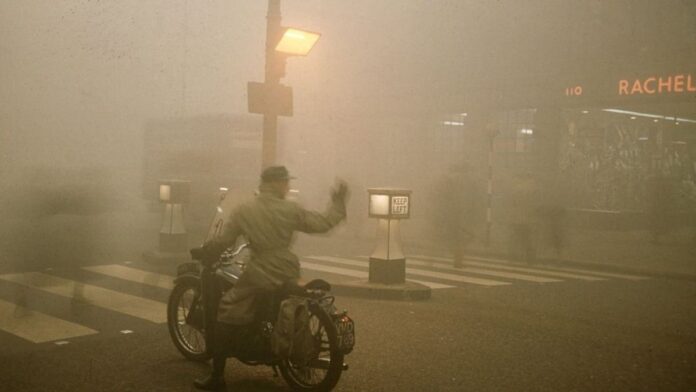The Great Smog of London was a severe environmental disaster that occurred in London, England, in December 1952. It was a period of prolonged air pollution that engulfed the city, causing widespread illness and death. The event was caused by a combination of factors, including weather conditions, industrial emissions, and domestic coal burning. The smog lasted for several days, and it is estimated that between 4,000 and 12,000 people died as a direct result of the event, making it one of the deadliest environmental disasters in history. In this article, we will explore the causes and effects of the Great Smog of London.
Contents
Causes of the Great Smog of London
The Great Smog of London was caused by a combination of factors, including weather conditions, industrial emissions, and domestic coal burning. In December 1952, London experienced a period of unusually cold weather, which caused an increase in domestic coal burning. This, combined with industrial emissions from factories and power plants, led to a significant increase in air pollution levels. The smog was exacerbated by the lack of wind, which prevented the pollutants from being dispersed.
Effects of the Great Smog of London
The Great Smog of London had a significant impact on the health of the population. The smog contained high levels of sulfur dioxide and other pollutants, which caused respiratory problems, including bronchitis and pneumonia. Hospitals were overwhelmed with patients, and many people died as a direct result of the event. The smog also had a significant impact on the environment, with vegetation and wildlife suffering as a result of the pollution.
Response to the Great Smog of London
The Great Smog of London was a wake-up call for the government and the public. In the aftermath of the event, the government introduced a series of measures to improve air quality, including the Clean Air Act of 1956. This legislation aimed to reduce the levels of pollution by introducing smoke control areas and promoting the use of cleaner fuels. The public also became more aware of the dangers of air pollution, and there was a shift towards cleaner forms of energy.
Lessons Learned from the Great Smog of London
The Great Smog of London was a tragic event, but it led to significant improvements in air quality. It demonstrated the importance of taking action to reduce pollution levels and highlighted the need for government intervention. The event also showed that public awareness and action can be a powerful force in driving change. Today, London has some of the cleanest air of any major city in Europe, with a range of measures in place to improve air quality.
Claims of Conspiracy
There have been various theories and claims of a possible conspiracy behind the Great Smog of London, but there is no concrete evidence to support such claims.
The smog was caused by a combination of weather conditions, industrial emissions, and domestic coal burning, as confirmed by scientific research and official reports. The prolonged cold weather and increased use of coal for heating during the winter months were the primary factors contributing to the event.
However, there have been claims that the government or industrial companies were aware of the risks associated with coal burning and pollution but chose to ignore them in pursuit of profit or political gain. Some have also suggested that the government deliberately downplayed the severity of the smog and its effects on public health.
While there may have been some negligence or lack of action on the part of the government and industrial companies, there is no concrete evidence to support any claims of a deliberate conspiracy behind the Great Smog of London. The event was a tragic environmental disaster that led to significant changes in legislation and public awareness of air pollution, but there is no evidence to suggest that it was anything other than a natural disaster caused by human activity.
However, in November 2016, a team of scientists unrevealed the mystery, claiming that sulfur dioxide is mostly produced by burning coal, but how sulfur dioxide changed to sulfuric acid was still a question later scientific research showed that this process Was helped by nitrogen dioxide and early natural mist. The incident in London forced the UK Parliament to enact a law on pollution and the UK enacted the Clean Air Act in 1956, according to which a full ban on the burning of pollutants across the United Kingdom was banned. Scientists are now hoping that London His research on the Great Smog will lead to other environmental breakthroughs and will help solve problems in countries with high air pollution rates.
Conclusion
The Great Smog of London was a significant environmental disaster that had a profound impact on the health and well-being of the population. It was caused by a combination of factors, including weather conditions, industrial emissions, and domestic coal burning. The event led to significant changes in legislation and public awareness, resulting in improved air quality in London and beyond. The lessons learned from the Great Smog of London continue to be relevant today, reminding us of the importance of taking action to protect our environment and our health.
Sources
- The Guardian: “The Great Smog of London 1952 – in pictures”
- The National Archives UK: “The Great Smog of London, 1952”
- BBC: “The Great Smog of London: A pollution disaster”
- London School of Economics: “The Great Smog of London, 60 years on”
- History.com: “The Great Smog of London”
- The Independent: “The Great Smog of London: why the disaster still matters”
- Scientific American: “When Smog Was a Silent Killer”
- New Scientist: “The Great Smog of London: A warning unheeded”
FACT CHECK: We strive for accuracy and fairness. But if you see something that doesn’t look right, please Contact us.
DISCLOSURE: This Article may contain affiliate links and Sponsored ads, to know more please read our Privacy Policy.
Stay Updated: Follow our WhatsApp Channel and Telegram Channel.












